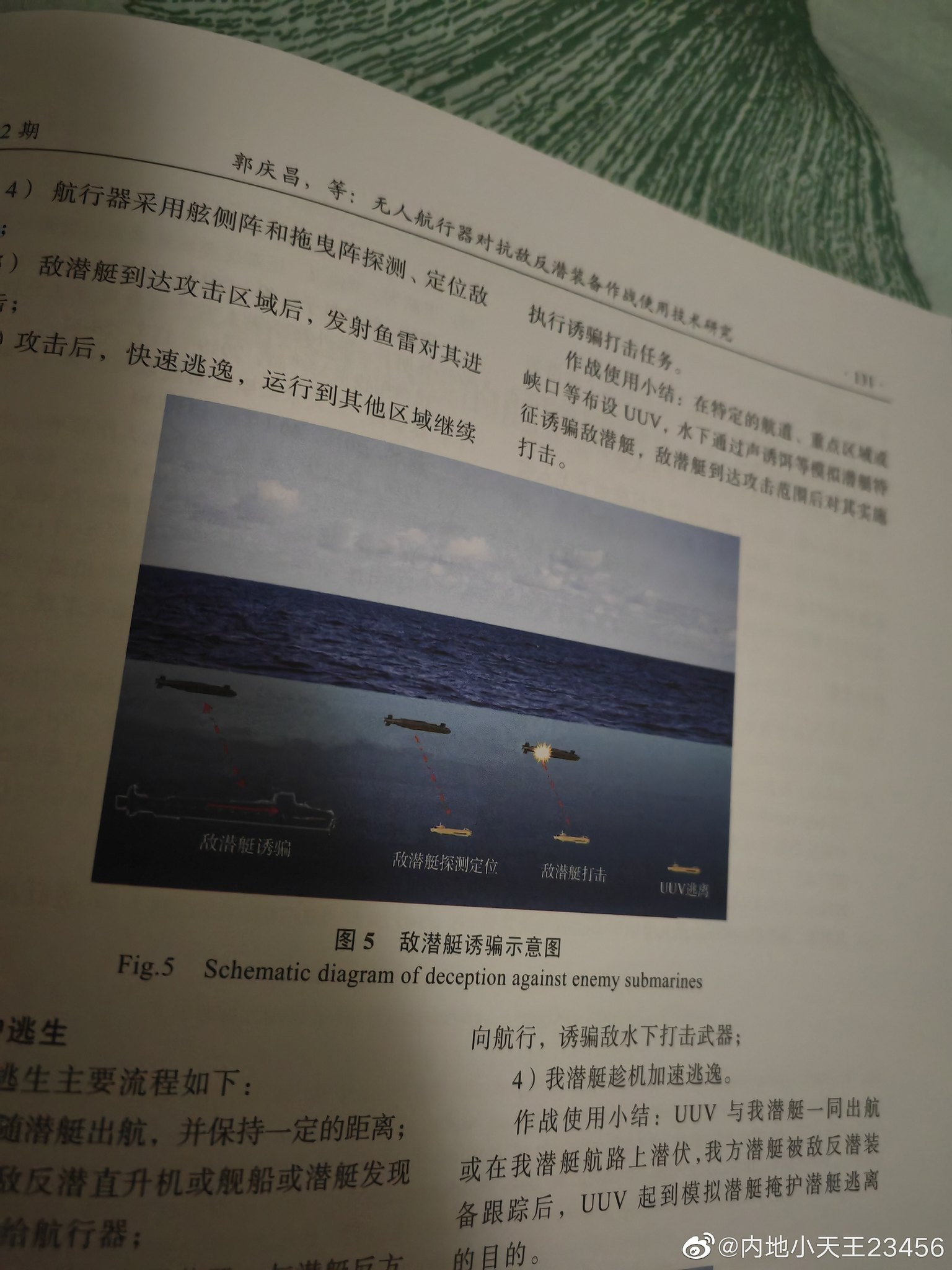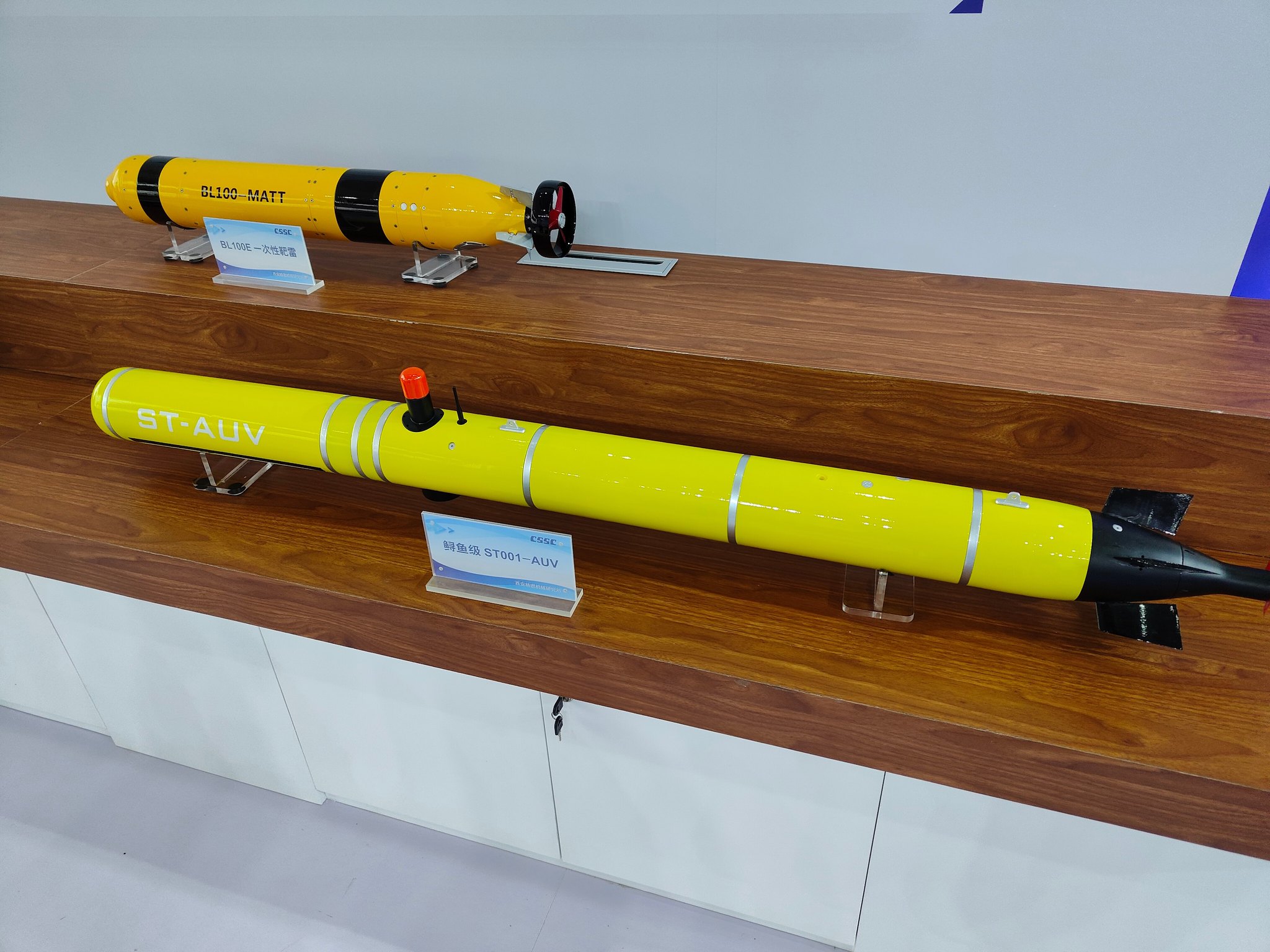You are using an out of date browser. It may not display this or other websites correctly.
You should upgrade or use an alternative browser.
You should upgrade or use an alternative browser.
Chinese Unmanned Underwater Vehicles (UUV)
- Thread starter by78
- Start date
Maybe we will see these coming out of the side boat bays in destroyers and frigates in the future. Though it does look pretty big!Initial testing of a new deployment and recovery system for UUVs has been . The system is designed with versatility in mind and can deploy and recover multiple types of UUVs, even in severe sea conditions.


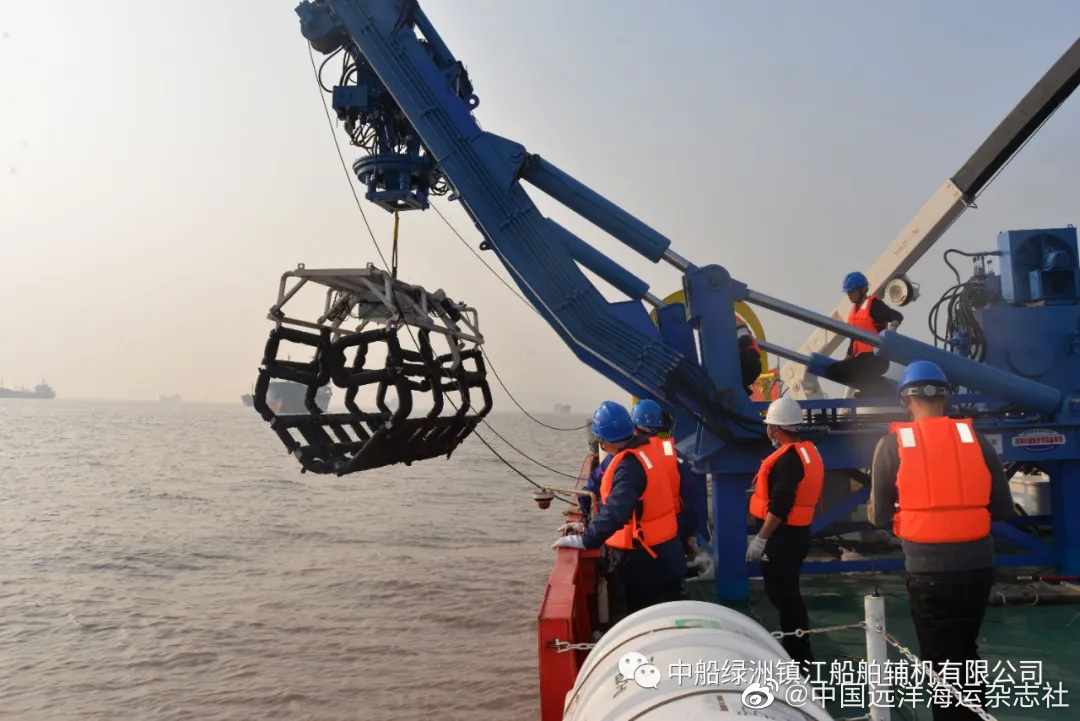
by78
General
The Haishen (海神) UUV. It's capable of operating at a depth of 6000 meters and features side-scanning sonar to perform detailed surveys. Very handy when looking for objects lying on seabed, such as a blackbox. Haishen is usually paired with a deep-sea towed vehicle (second image). The towed vehicle is used to perform initial wide-area scans to mark objects of interest, and Haishen is then sent to perform a more detailed examination.

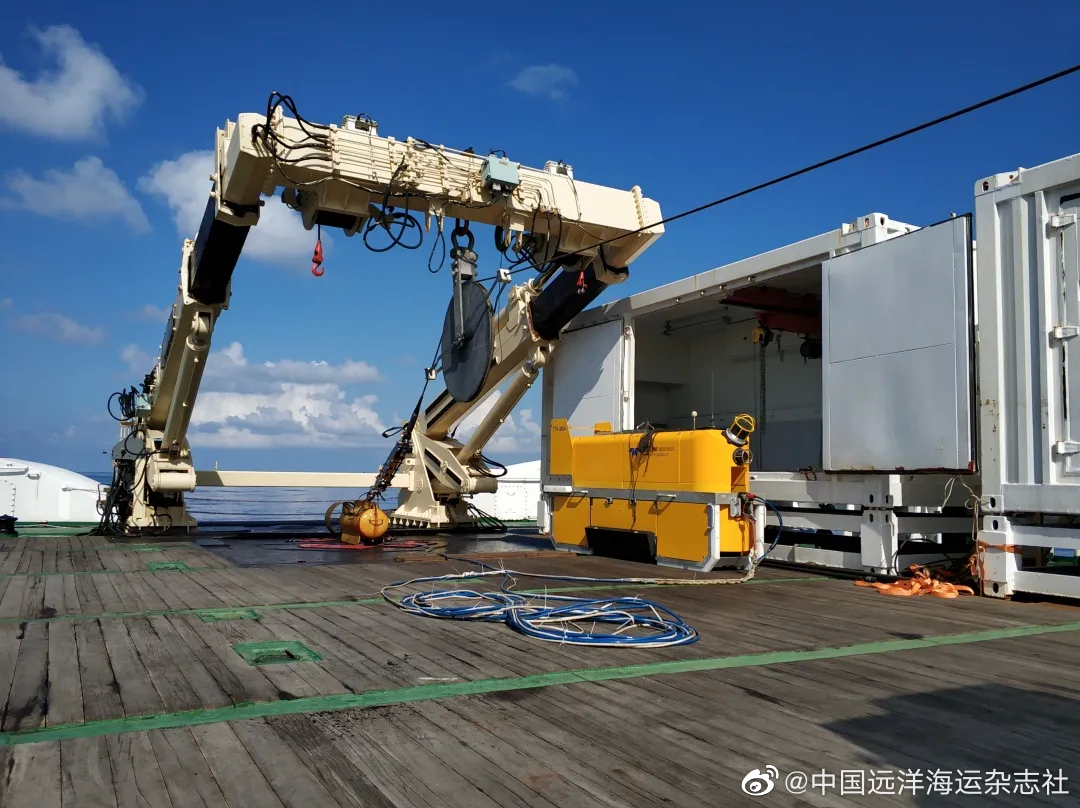


Last edited:
broadsword
Brigadier
Would be great if it could search for the MH370. Probably need the endurance to swim thousands of km.
by78
General
, a paper published in the July issue of .
It's an interesting read. The researchers propose a compact nuclear reactor design – using mature technologies – that can fit into an unmanned underwater vehicle the size of a 533mm torpedo, therefore making it deployable by existing naval assets. The reactor is to be partially seawater-cooled and use low-enriched fuel so as to minimize radioactivity (when the reactor is in off-state) and eliminate the need for heavy and bulky radiation shielding. Instead of using a steam turbine – which is obviously too large to fit – a thermoelectric generator is chosen. The proposed reactor is to be less than 3m in length, with a diameter smaller than 533mm. It weighs less than 750kg, with a power output of 100kW. The reactor is one-time use only, capable of operating at full power for 200 hours, enabling the underwater vehicle to dash for thousands of kilometers at high speed, or alternately cruise for longer ranges when operating at partial power. A battery is placed toward the rear of the vehicle, which is used to power the vehicle when it's initially deployed and before the reactor is started. This should put a safe distance between the vehicle and the crew because once the reactor starts, its radioactivity increases significantly. The battery also enables the vehicle to briefly reach higher speeds than relying on reactor power alone. Interestingly, the researchers propose that the reactor can be jettisoned, with the vehicle operating on battery power alone if necessary.

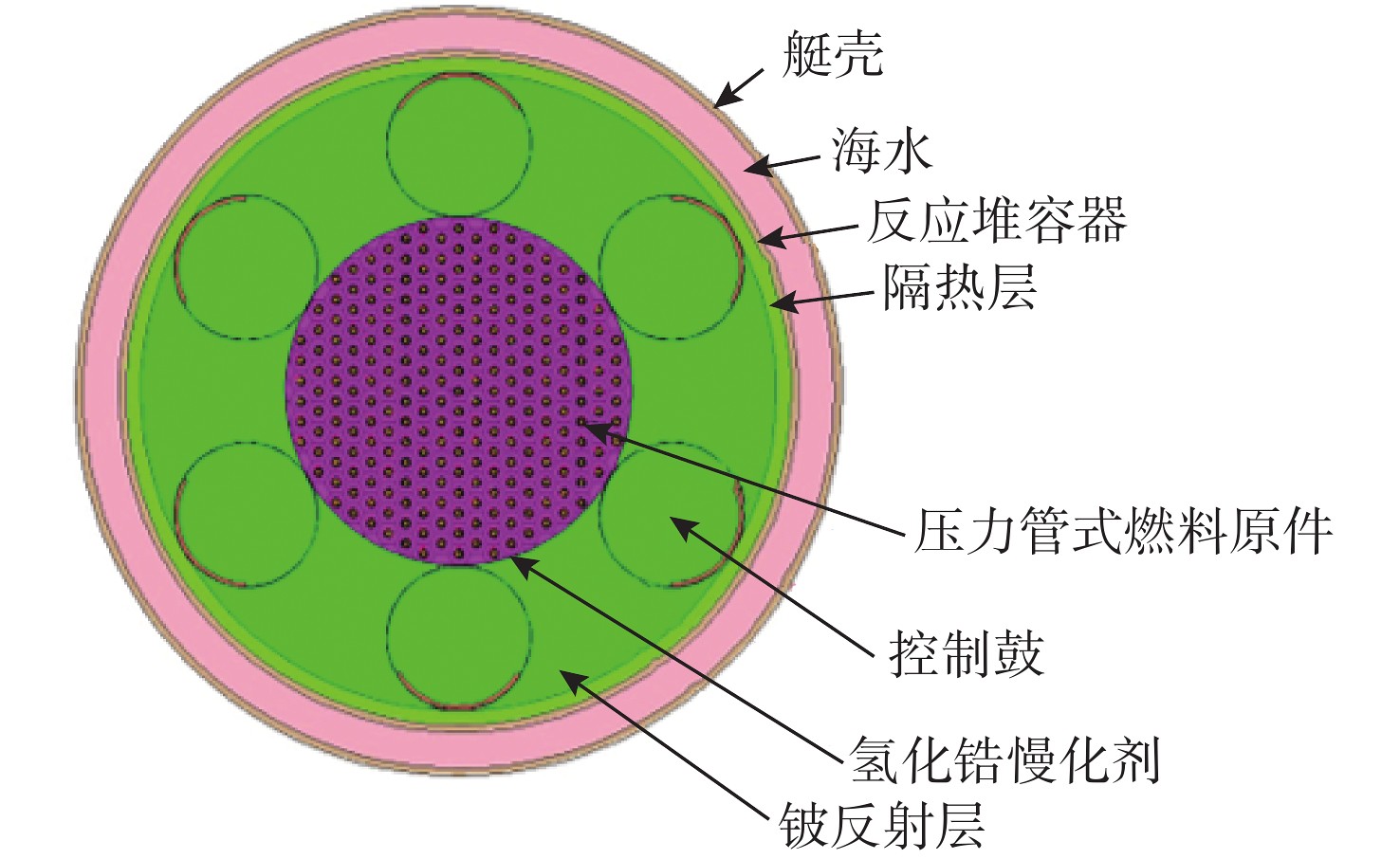

It's an interesting read. The researchers propose a compact nuclear reactor design – using mature technologies – that can fit into an unmanned underwater vehicle the size of a 533mm torpedo, therefore making it deployable by existing naval assets. The reactor is to be partially seawater-cooled and use low-enriched fuel so as to minimize radioactivity (when the reactor is in off-state) and eliminate the need for heavy and bulky radiation shielding. Instead of using a steam turbine – which is obviously too large to fit – a thermoelectric generator is chosen. The proposed reactor is to be less than 3m in length, with a diameter smaller than 533mm. It weighs less than 750kg, with a power output of 100kW. The reactor is one-time use only, capable of operating at full power for 200 hours, enabling the underwater vehicle to dash for thousands of kilometers at high speed, or alternately cruise for longer ranges when operating at partial power. A battery is placed toward the rear of the vehicle, which is used to power the vehicle when it's initially deployed and before the reactor is started. This should put a safe distance between the vehicle and the crew because once the reactor starts, its radioactivity increases significantly. The battery also enables the vehicle to briefly reach higher speeds than relying on reactor power alone. Interestingly, the researchers propose that the reactor can be jettisoned, with the vehicle operating on battery power alone if necessary.



Last edited:
Such ultra-long range (ULR) torpedoes could open up a new possibility of conducting conventional strike roles against very far-away targets, especially in terms of strategic bombing against enemies that are ocean-wide away. The news article by SCMP (which is also the first one to report it in the English news world) also hinted regarding the possibility of using the ULR tropedoes to strike targets in the Eastern Pacific., a paper published in the July issue of .
It's an interesting read. The researchers propose a compact nuclear reactor design – using mature technologies – that can fit into an unmanned underwater vehicle the size of a 533mm torpedo, therefore making it deployable by existing naval assets. The reactor is to be partially seawater-cooled and use low-enriched fuel so as to minimize radioactivity (when the reactor is in off-state) and eliminate the need for heavy and bulky radiation shielding. Instead of using a steam turbine – which is obviously too large to fit – a thermoelectric generator is chosen. The proposed reactor is to be less than 3m in length, with a diameter smaller than 533mm. It weighs less than 750kg, with a power output of 100kW. The reactor is one-time use only, capable of operating at full power for 200 hours, enabling the underwater vehicle to dash for thousands of kilometers at high speed, or alternately cruise for longer ranges when operating at partial power. A battery is placed toward the rear of the vehicle, which is used to power the vehicle when it's initially deployed and before the reactor is started. This should put a safe distance between the vehicle and the crew because once the reactor starts, its radioactivity increases significantly. The battery also enables the vehicle to briefly reach higher speeds than relying on reactor power alone. Interestingly, the researchers propose that the reactor can be jettisoned, with the vehicle operating on battery power alone if necessary.



However, I would like to expand further on this topic.
My point would be if a long-range land-attack missile could be feasibly fitted in front of these ULR torpedoes, those ULR torpedo-tipped missiles could have their strike range extended a lot more, possibly even rivaling that of the ICBMs.
For the purpose of this example and to simplify things up, the missile which I have chosen is the DF-100 missile (or CJ-100).
According to the Overt Defense (OVD) webpage on said missile, here are the estimated dimensions:
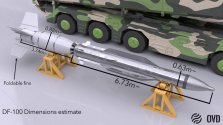
The diameter of the DF-100 missile (~0.63 meters at missile and ~0.88 meters at booster) would be larger than the diameter of said ULR torpedo (~0.53 meters). Fitting the DF-100 missile onto the ULR torpedo would also render the whole unit too long to be carried onboard PLAN warships, so the whole unit has to be launched from land-based launchers from the Chinese coastline, or specially modified PLAN LPDs.
To explain it further, said ULR torpedo-mounted DF-100 would first be travelling underwater across the Pacific using the ULR torpedo's propulsion. This method would be slower than typical ICBMs, but travelling underwater meant that the whole unit would be very difficult to detect and defend against.
Once within the boost-launch range of the DF-100 missile (which is around 100 kilometers from the southern Californian coastline in this scenario), the ULR torpedo-mounted DF-100 missile would seperate from the ULR torpedo, burst from the water surface and then dash towards its designated target at supersonic speeds. This would be largely similar in style to how a submarine torpedo tube-launched missile operates, except with some modifications and changes.
The ULR torpedo, meanwhile, could either lose its function after the DF-100 missile separation and just sink into the bottom of the ocean, or continue towards its designated target located on the coastline, akin how a normal torpedo operates.
According to the OVD webpage, the DF-100 missile is estimated to have a strike range of around 2000 kilometers. According to Wikipedia article, the DF-100 missile is estimated to have a maximum strike range of up to 3000 kilometers.
Therefore, if the ULR torpedo-mounted DF-100 missile has 2000-kilometer strike range, the strike range map would look like this:
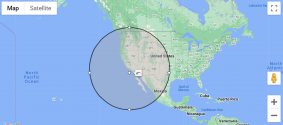
The DF-100 would be effective in covering almost half of the continental United States.
Meanwhile, if the ULR torpedo-mounted DF-100 missile has a strike range of 3000 kilometers, the strike range map would look like this:
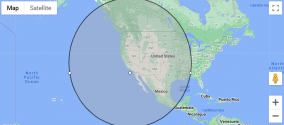
The DF-100 would be sufficient to cover around two-thirds of the continental United States.
Such ULR torpedo-mounted long-range land-attack missile would be very useful in a hypothetical war in the Western Pacific, should the United States choose to go into a full scale confrontation and war with China over Taiwan, for instance.
I recalled that someone in this forum has brought up the (very important) question on whether China has the means and capabilities to strike against the vital infrastructures, facilities and industries of the United States (especially on the mainland United States) in case of an all-out war with China.
This is because the United States who have multiple military bases and stations located along and beyond China's frontdoor and backyard, the United States military could swiftly and credibly threaten China's cities, bases, infrastructures, facilities and industries with tactical and strategic attacks plus bombings. Much of those are located within just a mere 2000 kilometers from China's coastline, where all of which would be critical in supporting China's war effort in the Western Pacific:
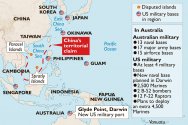
On the flipside, China does not have any military bases and stations located in Latin America that could serve as an equivalent answer to the United States. China also does not have any bombers in service that could reliably hit the mainland United States either. Even the upcoming H-20 may only be able to conduct strategic bombing runs within and up to the 3rd Island Chain and Hawaii.
In fact, the only feasible tool in China's own shed that could reliably strike the mainland United States are her ICBMs (DF-31As and DF-41s). However, despite China's firm promise of the "No First Use" policy regarding her nuclear arsenal, launching even just conventionally-tipped ICBMs against the United States carries a huge risk of being misintepreted as a nuclear strike from China, and could very well prompt a nuclear response against China from the United States military.
Therefore, I believe that China should pursue the rapid development and entry into service of underwater-based ultra-long range strike weapons that could reliably conduct conventional attacks against the command centers, military bases and facilities, infrastructures, and warmaking industries on the mainland United States. Such strategic weapons would be useful in hampering the war effort of the United States, and therefore, potentially providing China with greater chances of success in a hypothetical war in the the Western Pacific.
Of course, in order to make such strategic weapons viable for its designated role, China needs to make sure that such weapons can be deployed in consistently large numbers over significant periods of time. That would require China to possess the capability to manufacture and bring into bear these ULR torpedo-mounted missiles in the hundreds, or even thousands, every month, which would be launched against the continental United States in a constant strategic bombing campaign, similar in style to how the USAAF and RAF conducted virtually non-stop strategic bombing campaigns against the Axis Powers for the later 3 years of the Second World War.
In short, punches have to be replied with equal punches. You can't just expect to just take hits and beatings and not responding in kind. Because there have been too many cases where people who only know how to dish out pain without ever expecting themselves to be hurt in the proces.
However, I would not condone any suggestions to fit nuclear warheads on this ULR torpedo-mounted long-range land strike missiles except when a nuclear war is inevitable. In fact, I believe nuclear war should be off the warplanning table except for deterrence. China must never be the first one to push the nuclear red button, unless the very survival of her people and her civilization state is under dire threat.
Last edited:
Such ultra-long range (ULR) torpedoes could open up a new possibility of conducting conventional strike roles against very far-away targets, especially in terms of strategic bombing against enemies that are ocean-wide away. The news article by SCMP (which is also the first one to report it in the English news world) also hinted regarding the possibility of using the ULR tropedoes to strike targets in the Eastern Pacific.
However, I would like to expand further on this topic.
My point would be if a long-range land-attack missile could be feasibly fitted in front of these ULR torpedoes, those ULR torpedo-tipped missiles could have their strike range extended a lot more, possibly even rivaling that of the ICBMs.
For the purpose of this example and to simplify things up, the missile which I have chosen is the DF-100 missile (or CJ-100).
According to the Overt Defense (OVD) webpage on said missile, here are the estimated dimensions:
View attachment 98677
The diameter of the DF-100 missile (~0.63 meters at missile and ~0.88 meters at booster) would be larger than the diameter of said ULR torpedo (~0.53 meters). Fitting the DF-100 missile onto the ULR torpedo would also render the whole unit too long to be carried onboard PLAN warships, so the whole unit has to be launched from land-based launchers from the Chinese coastline, or specially modified PLAN LPDs.
To explain it further, said ULR torpedo-mounted DF-100 would first be travelling underwater across the Pacific using the ULR torpedo's propulsion. This method would be slower than typical ICBMs, but travelling underwater meant that the whole unit would be very difficult to detect and defend against.
Once within the boost-launch range of the DF-100 missile (which is around 100 kilometers from the southern Californian coastline in this scenario), the ULR torpedo-mounted DF-100 missile would seperate from the ULR torpedo, burst from the water surface and then dash towards its designated target at supersonic speeds. This would be largely similar in style to how a submarine torpedo tube-launched missile operates, except with some modifications and changes.
The ULR torpedo, meanwhile, could either lose its function after the DF-100 missile separation and just sink into the bottom of the ocean, or continue towards its designated target located on the coastline, akin how a normal torpedo operates.
According to the OVD webpage, the DF-100 missile is estimated to have a strike range of around 2000 kilometers. According to Wikipedia article, the DF-100 missile is estimated to have a maximum strike range of up to 3000 kilometers.
Therefore, if the ULR torpedo-mounted DF-100 missile has 2000-kilometer strike range, the strike range map would look like this:
View attachment 98680
The DF-100 would be effective in covering almost half of the continental United States.
Meanwhile, if the ULR torpedo-mounted DF-100 missile has a strike range of 3000 kilometers, the strike range map would look like this:
View attachment 98681
The DF-100 would be sufficient to cover around two-thirds of the continental United States.
Such ULR torpedo-mounted long-range land-attack missile would be very useful in a hypothetical war in the Western Pacific, should the United States choose to go into a full scale confrontation and war with China over Taiwan, for instance.
I recalled that someone in this forum has brought up the (very important) question on whether China has the means and capabilities to strike against the vital infrastructures, facilities and industries of the United States (especially on the mainland United States) in case of an all-out war with China.
This is because the United States who have multiple military bases and stations located along and beyond China's frontdoor and backyard, the United States military could swiftly and credibly threaten China's cities, bases, infrastructures, facilities and industries with tactical and strategic attacks plus bombings. Much of those are located within just a mere 2000 kilometers from China's coastline, where all of which would be critical in supporting China's war effort in the Western Pacific:
View attachment 98682
On the flipside, China does not have any military bases and stations located in Latin America that could serve as an equivalent answer to the United States. China also does not have any bombers in service that could reliably hit the mainland United States either. Even the upcoming H-20 may only be able to conduct strategic bombing runs within and up to the 3rd Island Chain and Hawaii.
In fact, the only feasible tool in China's own shed that could reliably strike the mainland United States are her ICBMs (DF-31As and DF-41s). However, despite China's firm promise of the "No First Use" policy regarding her nuclear arsenal, launching even just conventionally-tipped ICBMs against the United States carries a huge risk of being misintepreted as a nuclear strike from China, and could very well prompt a nuclear response against China from the United States military.
Therefore, I believe that China should pursue the rapid development and entry into service of underwater-based ultra-long range strike weapons that could reliably conduct conventional attacks against the command centers, military bases and facilities, infrastructures, and warmaking industries on the mainland United States. Such strategic weapons would be useful in hampering the war effort of the United States, and therefore, potentially providing China with greater chances of success in a hypothetical war in the the Western Pacific.
Of course, in order to make such strategic weapons viable for its designated role, China needs to make sure that such weapons can be deployed in consistently large numbers over significant periods of time. That would require China to possess the capability to manufacture and bring into bear these ULR torpedo-mounted missiles in the hundreds, or even thousands, every month, which would be launched against the continental United States in a constant strategic bombing campaign, similar in style to how the USAAF and RAF conducted virtually non-stop strategic bombing campaigns against the Axis Powers for the later 3 years of the Second World War.
In short, punches have to be replied with equal punches. You can't just expect to just take hits and beatings and not responding in kind. Because there have been too many cases where people who only know how to dish out pain without ever expecting themselves to be hurt in the proces.
However, I would not condone any suggestions to fit nuclear warheads on this ULR torpedo-mounted long-range land strike missiles except when a nuclear war is inevitable. In fact, I believe nuclear war should be off the warplanning table except for deterrence. China must never be the first one to push the nuclear red button, unless the very survival of her people and her civilization state is under dire threat.
Please refer to the updated version in the China Ballistic Missile and Nuclear Arms Thread.
China Ballistic Missiles and Nuclear Arms Thread
No, it is perfect. US is gonna lose a huge talent pool due to the paranoia They are sinophobia. Serve them right!
www.sinodefenceforum.com
China Ballistic Missiles and Nuclear Arms Thread
No, it is perfect. US is gonna lose a huge talent pool due to the paranoia They are sinophobia. Serve them right!
www.sinodefenceforum.com
Thank you.
by78
General
Underwater guerrilla warfare and ambush. UUVs are strategically deployed at certain shipping lanes and choke points, where they use acoustic decoys and other methods to lure enemy submarines into traps. Once enemy submarines get within range, UUVs launch torpedo attacks and then quickly withdraw and sail to the next area to set up traps all over again, a kind of underwater shoot-and-scoot tactic.
